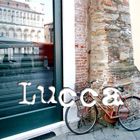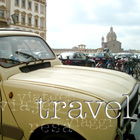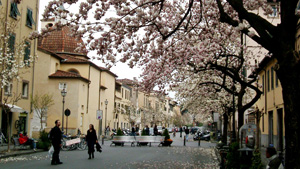
|
THE CITY CENTER IS ENCLOSED WITHIN WALLS OVERGROWN WITH GREEN & SERVING AS PARKLAND Updated 6 June 2006 As you approach the city by train, you find it is nestled in the green Tuscan countryside, but unassuming, unimposing, a humble quiet city that seems expert in giving back more than it asks. The city's medieval walls are still intact, and the top of the walls is parkland comprising a four kilometer hike around the city center. On a sunny day, Lucca's characteristic yellow buildings and rustic exposed brick street-corners, its white cathedrals and meandering streets, make for something like a game of light and shadow, and a pleasant stroll among delicious pasticcerias and family-run restaurants. Though known for olive oil and for its walls, the city of Lucca itself offers the visitor some unique monuments and a pedestrian center closed to cars and full of opportunities for shopping, featuring a Tuscan specialty, leather goods. Near the river Serchio, Lucca sits on a fertile plain, which has helped build a strong agricultural tradition throughout the province. The city is also not far from the Ligurian sea, and as the capital of Lucca province, enjoys relative proximity to mountain spa towns and quiet villages like Bagni di Lucca. Surprising to those who expect a medieval city, steeped in the past and clinging to tradition, Lucca is a modern city with the luxuriant pace of a mountain village. The city center is closed to most automotive traffic, though small electric buses shuttle the locals around, and bicycles roam the entire space of the city. Tourists are known to enjoy renting bikes and riding the pathway across the full length of the city walls, and a cottage industry of bike rentals exists to serve this tendency. Lucca's history began with the Etruscan settlement, though traces have been found linking the city to earlier Ligurian peoples. In 180 BC, the city became a Roman colony, during which period its grid plan was implemented. The Piazza San Michele occupies the site of the Roman forum, and the Piazza del Anfiteatro, uniquely oblong in shape, sits over the site of the ancient Roman amphitheatre. Under the Lombard kingdoms, it became a more developed center of artisanry and production, and by the 10th century, was the capital of the feudal margravate of Tuscany, enjoying a degree of independence from Roman control, but owing political allegiance to the Holy Roman Emperor. Its silk trade developed during the 11th century as a western rival to the silks of the Byzantine empire, which extended its influence into northern Italy and necessitated a Roman alternative in many areas, to defend the western church and its territories against economic and cultural dominance from the east. Venice at the time was intimately linked to Byzantium through trade, areas of northeastern Italy were frontier outposts of the Byzantine sphere of influence. The silk trade brought a new era of prosperity to Lucca, which was chartered as an independent comune in 1160 AD. Lucca would remain a self-governing republic for nearly 5 centuries, and even served as home in exile for Dante, when he had to flee the reach of major feudal families with control of much of Tuscany, under the broader European system. For a brief period in the 14th century, an attempt was made to seize power and establish a principality, but the Lucchesi rejected the rule of Uguccione della Faggiuola after only two years. After his ouster, the city came under the control of condottiere Castruccio Castracani, who served as both tyrant and protector, and steeled the city to a strength that rivaled Florence for regional influence. Castracani would defeat the ruling Guelphs of Florence several times in battle, and would become the subject of one of Machiavelli's most important books on political history. Eventually, the independent comune was occupied by Bavarian troops, sold into Genovese contro, then passed from Parma's Rossi to the Veronese, the Florentines and the Pisans, was seized by Napoleon in 1805, fell under Bourbon control, then was integrated into greater Tuscany in 1847. Its turbulent history nevertheless saw Lucca maintain its republican charter as an independent comune with greater effectiveness over time than any other Italian city state except Venice. Today's Lucca is well-known for its olive oils and for the architectural attraction of its many churches and its medieval towers. The Piazza Napoleone hosts free concerts and cultural events, and the Piazza San Michele, surrounding la Chiesa di San Michele in Foro, hosts street markets for holiday events, seasonal foods and everyday produce. The standard of living is high, and its main walking street is a shopping thoroughfare that will not disappoint visitors with refined tastes. Its cafés are varied and offer both the traditional Italian stand-up espresso bar, where locals enjoy a morning chat over pastry and strong espresso, and elegant belle-epoque locales, accessible at prices that allow any visitor to spend a little time writing or relaxing, away from the bustle of the street. [s] |
|||||||||||||||||
|
||||||||||||||||||











